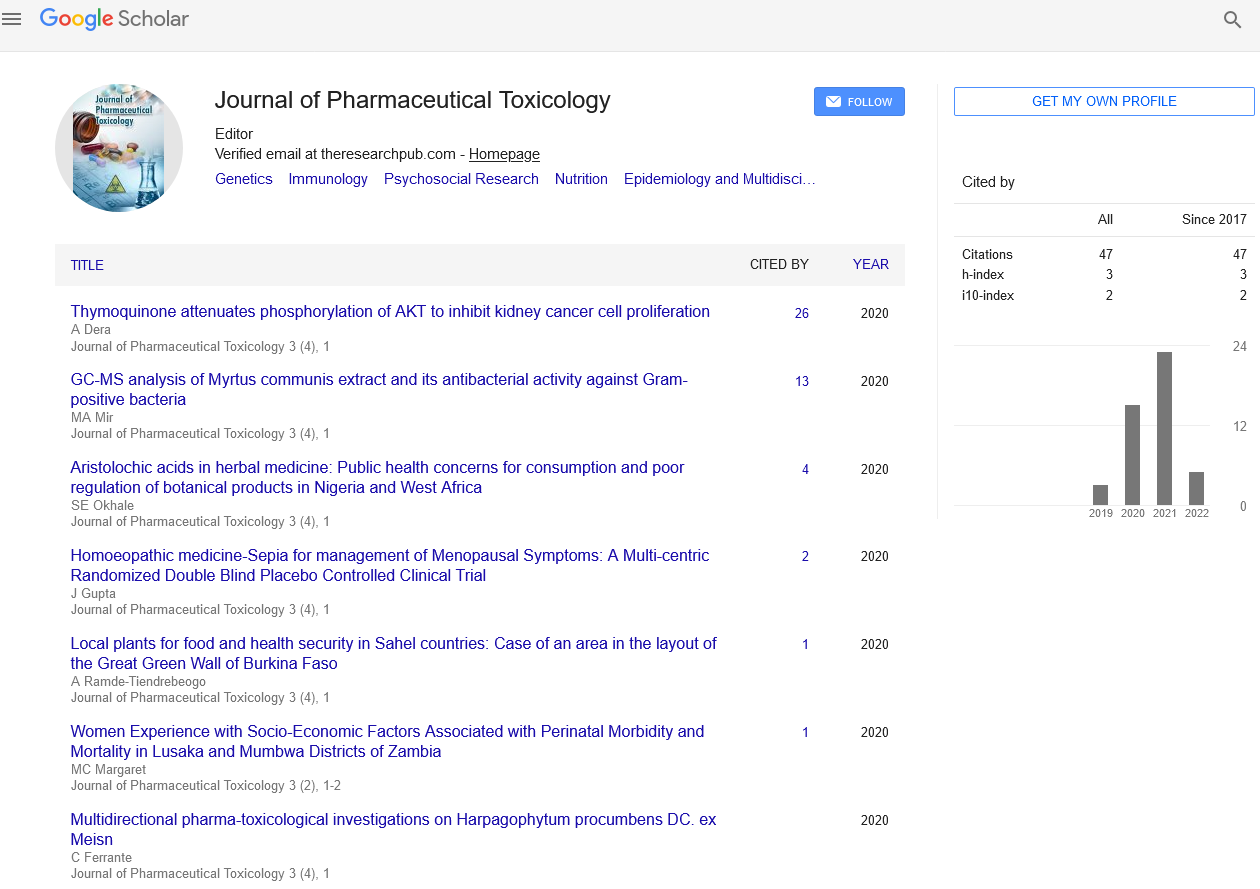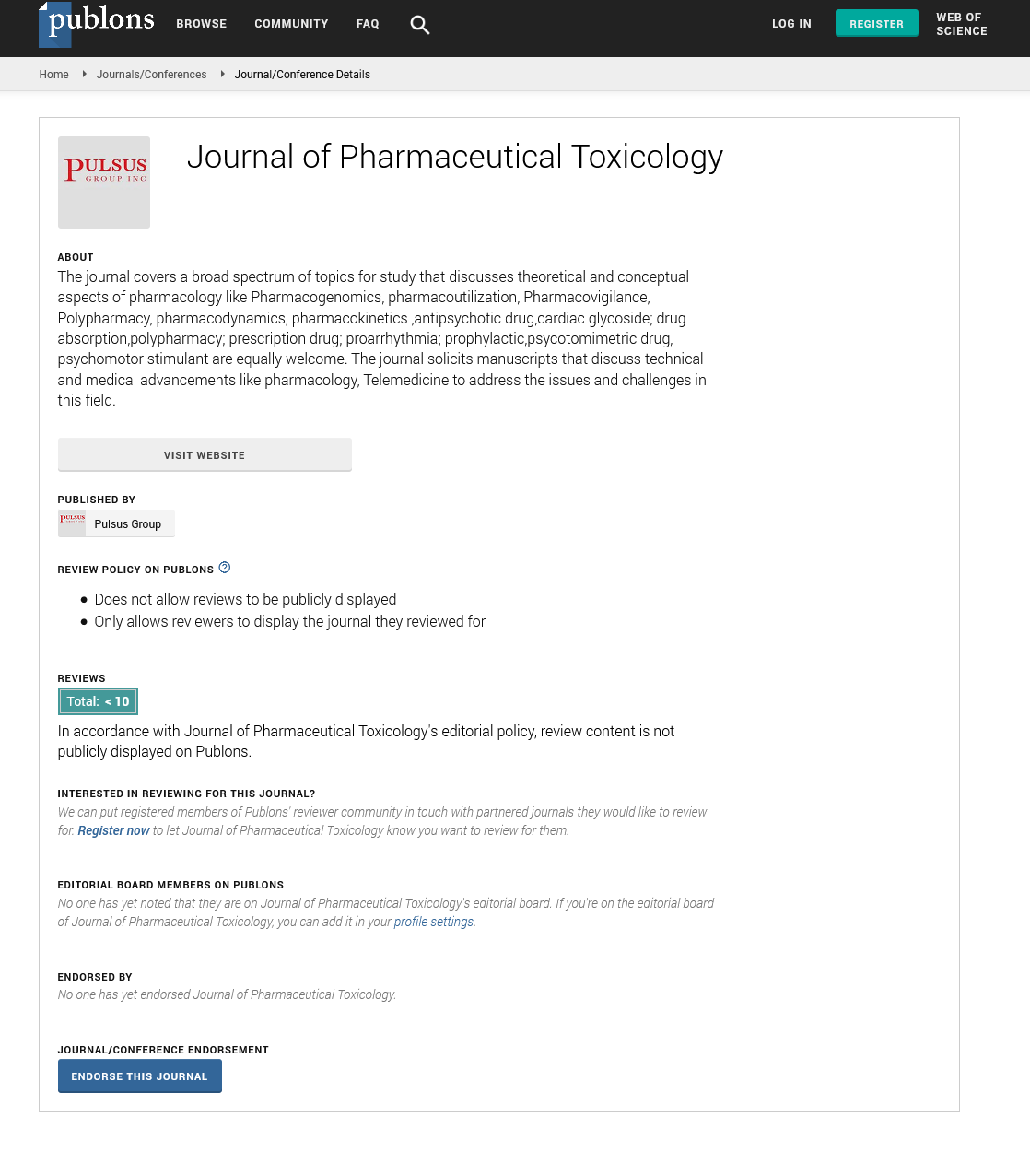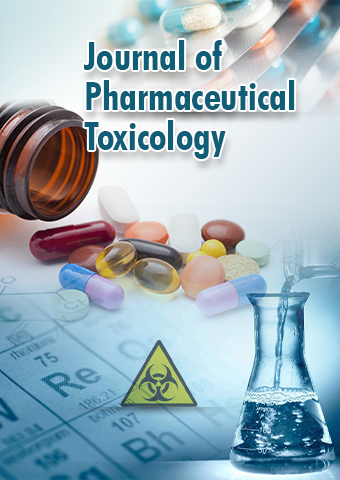Commentary - Journal of Pharmaceutical Toxicology (2023) Volume 6, Issue 3
Advancements in Targeted Drug Delivery Systems for Enhanced Therapeutic Outcomes
Emily George*
University of Waikato, New Zealand
- *Corresponding Author:
- Emily George
University of Waikato, New Zealand
E-mail: georgeemily@rediff.com
Abstract
Introduction
The field of pharmaceuticals has witnessed significant advancements in recent years, particularly in the area of targeted drug delivery systems. These innovative systems aim to enhance the efficacy and safety of therapeutic interventions by precisely targeting specific sites within the body, minimizing side effects, and maximizing the therapeutic response. This article explores some of the notable advancements in targeted drug delivery systems and their potential impact on improving patient outcomes.
Nanotechnology has emerged as a promising avenue for targeted drug delivery. Nanoparticles, such as liposomes, polymeric nanoparticles, and Dendrimers, can be engineered to encapsulate drugs and selectively deliver them to the intended site of action. These nanoparticles offer advantages like controlled release, improved drug stability, and enhanced cellular uptake, making them highly effective in delivering drugs to specific tissues or cells. Stimuli-responsive drug delivery systems have gained attention due to their ability to release drugs in response to specific triggers, such as changes in pH, temperature, enzyme activity, or light exposure. These systems enable drug release at the target site, avoiding off-target effects and reducing systemic toxicity. Examples include pH-responsive polymers, thermo sensitive liposomes, and light-activated nanoparticles [1-3].
Material & Methods
Nanotechnology has revolutionized the field of drug delivery by enabling precise control over the release and targeting of therapeutic agents. Researchers have developed various nano-sized carriers such as liposomes, polymeric nanoparticles, and Dendrimers that can encapsulate drugs and deliver them to specific cells or tissues. These nanocarriers offer advantages such as increased drug stability, prolonged circulation time, and enhanced cellular uptake, leading to improved therapeutic outcomes.
Various targeting strategies have been developed to improve drug accumulation at the intended site. Ligand-based targeting involves attaching specific ligands (e.g., antibodies, peptides) to drug carriers, facilitating their recognition and binding to receptors overexpressed on target cells. Other approaches include utilizing magnetic fields, ultrasound, or external stimuli to guide drug carriers to the desired location, thereby enhancing drug delivery precision. Advancements in genomics and molecular biology have paved the way for personalized medicine, tailoring treatments to individual patients. Targeted drug delivery systems play a crucial role in personalized medicine by delivering therapeutics based on specific patient characteristics. This approach minimizes adverse reactions and optimizes treatment outcomes, making it a promising avenue for various diseases, including cancer, cardiovascular disorders, and autoimmune conditions.
Discussion
Combination therapies involving multiple drugs or drug classes have gained prominence in treating complex diseases. Targeted drug delivery systems enable the simultaneous or sequential release of different drugs, facilitating synergistic effects and reducing drug resistance. Moreover, multifunctional carriers can integrate diagnostics, imaging agents, or therapeutic agents within a single platform, allowing for real-time monitoring and personalized treatment adjustments. Advancements in targeted drug delivery systems offer tremendous potential for revolutionizing the pharmaceutical landscape. These systems provide precise and efficient drug delivery, leading to improved therapeutic outcomes, reduced side effects, and enhanced patient compliance. Continued research and development in this field will further refine these technologies and broaden their applications, bringing us closer to the era of personalized medicine and tailored therapies [4,5].
The field of pharmaceutical research and development has witnessed significant advancements in recent years, particularly in the area of targeted drug delivery systems. These innovative approaches aim to improve the efficacy and safety of therapeutic treatments by delivering drugs directly to the site of action within the body, minimizing side effects and maximizing therapeutic benefits. This article explores some of the recent breakthroughs and trends in targeted drug delivery systems [6,7].
Stimulus-responsive drug delivery systems respond to specific internal or external stimuli to trigger drug release at the desired site. These stimuli can include changes in pH, temperature, enzyme activity, or even light exposure. By incorporating responsive materials into drug delivery systems, researchers have achieved controlled drug release profiles, ensuring that the therapeutic agent is released only when and where it is needed. This approach minimizes off-target effects and improves drug efficacy. To achieve site-specific drug delivery, researchers have developed various targeting strategies. One approach involves the use of ligands or antibodies that specifically recognize receptors or markers on the surface of target cells. By attaching these targeting moieties to drug carriers, researchers can selectively deliver drugs to diseased cells while sparing healthy tissues. Another strategy involves exploiting the unique properties of certain tissues, such as the enhanced permeability and retention effect in tumors, to passively accumulate drug carriers at the target site [8,9].
Advancements in targeted drug delivery have paved the way for personalized medicine, where treatments are tailored to individual patients based on their specific characteristics. Theranostics, a combination of therapy and diagnostics, involves using drug delivery systems that can simultaneously deliver therapeutics and monitor treatment response. This approach enables real-time monitoring of drug efficacy, allowing for adjustments in treatment strategies as needed [10].
Conclusion
Despite the progress made in targeted drug delivery systems, several challenges remain. These include the need for efficient and scalable manufacturing methods, overcoming biological barriers, and ensuring long-term stability of the drug carriers. Future research efforts will likely focus on addressing these challenges and further optimizing targeted drug delivery systems. Additionally, the integration of artificial intelligence and machine learning techniques may facilitate the design and optimization of personalized drug delivery systems. Targeted drug delivery systems hold great promise for improving the efficacy and safety of pharmaceutical treatments. The advancements in nanotechnology, stimulus-responsive systems, targeting strategies, personalized medicine, and theranostics are revolutionizing the pharmaceutical industry. Continued research and development in this field will likely lead to the development of more efficient and precise drug delivery systems, ultimately benefiting patients by providing enhanced therapeutic outcomes and minimizing side effects.
Acknowledgement
None
Conflict of Interest
None
References
- Berthe–Aucejo A, Nguyen PKH, Angoulvant F et al. Retrospective study of irrational prescribing in French paediatric hospital: Prevalence of inappropriate prescription detected by Pediatrics: Omission of Prescription and Inappropriate prescription (POPI) in the emergency unit and in the ambulatory setting. BMJ Open.9, 45–66 (2015).
- Al Balushi KA, Al–Sawafi F, Al–Ghafri F et al. Drug utilization pattern in an Omani pediatric population. J Basic Clin Pharm. 4, 68–72 (2014).
- Al–Badri A. Almuqbali J, Al–Rahbi K et al. A Study of the Paediatric Prescriptions at the Tertiary Care Hospital in Oman. J Pharmaceut. Res.5, 17–56 (2020).
- Al–Maqbali, Haridass S, Hassali M et al. Analysis of Pediatric Outpatient Prescriptions in a Polyclinic of Oman. Glob J Med Res. 19, 2249–4618 (2019).
- Bakaki PM, Horace A, Dawson N et al. Defining pediatric polypharmacy: A scoping review. PLoS ONE . 13, 56–99 (2018).
- Lemeshow S, Hosmer DW. A review of goodness of fit statistics for use in the development of logistic regression models. Am J. Epidemiol.115, 92–106 (1982).
- Wallace E, McDowell R, Bennett K et al. Impact of Potentially Inappropriate Prescribing on Adverse Drug Events, Health Related Quality of Life and Emergency Hospital Attendance in Older People Attending General Practice: A Prospective Cohort Study. J Gerontol A Biol Sci Med Sci. 72, 271–277 (2017)
- Cahir C, Moriarty F, Teljeur C et al. Potentially inappropriate prescribing and vulnerability and hospitalization in older community–dwelling patients. Ann Pharmacother. 48, 1546–1554 (2018).
- Cullinan S, O’Mahony D, Fleming A et al. A meta–synthesis of potentially inappropriate prescribing in older patients. Drugs Aging.31, 631–638(2014).
- Liew TM, Lee CS, Goh Shawn KL et al. Potentially Inappropriate Prescribing Among Older Persons: A Meta–Analysis of Observational Studies. Ann Fam Med. 17, 257–266 (2019).
Indexed at, Google Scholar, Cross ref
Indexed at, Google Scholar, Cross ref
Indexed at, Google Scholar, Cross ref
Indexed at, Google Scholar, Cross ref
Indexed at, Google Scholar, Cross ref
Indexed at, Google Scholar, Cross ref


